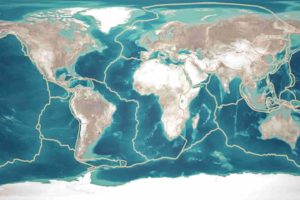
A new study of rocks that formed billions of years ago lends fresh insight into how Earth’s plate tectonics, or the movement of large pieces of Earth’s outer shell, evolved over the planet’s 4.56-billion-year history.
A report of the findings, published August 7 in Nature, reveals that, contrary to previous studies that say plate tectonics has operated throughout Earth’s history or that it emerged only 0.7 billion years ago, plate tectonics actually evolved over the last 2.5 billion years. This new timeline impacts researchers’ models for understanding how Earth has changed.
“One of the key ways to understand how Earth has evolved to become the planet that we know is plate tectonics,” says Robert Holder, a Postdoctoral Fellow in Earth and Planetary Sciences at Johns Hopkins University and the paper’s first author.
Plate tectonics dictates how continents drift apart and come back together, helps explain where volcanoes and earthquakes occur, predicts cycles of erosion and ocean circulation, and how life on Earth has evolved.
In a bid to resolve the mystery of how and when plate tectonics emerged on Earth, Holder and the research team examined a global compilation of metamorphic rocks that formed over the past 3 billion years at 564 sites. Metamorphic rocks are rocks that, through the process of being buried and heated deep in the Earth’s crust, have transformed into a new type of rock. Scientists can measure the depth and temperatures at which metamorphic rocks form, and thereby constrain heat flow at different places in Earth’s crust. Because plate tectonics strongly influences heat flow, ancient metamorphic rocks can be used to study plate tectonics in Earth’s past.
The research team compiled data on the temperatures and depths at which the metamorphic rocks formed and then evaluated how these conditions have changed systematically through geological time. From this, the team found that plate tectonics, as we see it today, developed gradually over the last 2.5 billion years.
“The framework for much of our understanding of the world and its geological processes relies on plate tectonics,” says Holder. “Knowing when plate tectonics began and how it changed impacts that framework.”
Clarity on when plate tectonics began and whether it was different in Earth’s past can help scientists better understand why we find certain rocks and minerals where we do and how they formed, says Holder.
Other authors on this paper include Daniel Viete of the Johns Hopkins University; Michael Brown of the University of Maryland, College Park; and Tim Johnson of Curtin University
Reference:
Robert M. Holder, Daniel R. Viete, Michael Brown & Tim E. Johnson. Metamorphism and the evolution of plate tectonics. Nature, 2019 DOI: 10.1038/s41586-019-1462-2
Note: The above post is reprinted from materials provided by Johns Hopkins University.










